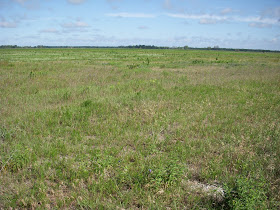In February 2009, Lindsay and I attended the
Wild Things conference in Chicago. One of the presentations that we attended was given by Carl Strang of
Mayslake Forest Preserve and
Nature Inquiries. Carl discussed the singing insects, a group of species to which Lindsay and I were nearly oblivious. Carl's talk opened our eyes and ears, and we've been watching and listening for singing insects since.

Fast forward to 12 June 2010. I had just finished mowing our trails and was taking Bootypants for her daily walk when I heard a singing insect on our property for the first time this year. The song was a soft electric buzz that lasted for 10 to 15 seconds or more, sometimes broken into a series of shorter calls, sometimes continuous. I thought it sounded a bit like a meadow katydid, but I thought it seemed a bit early for them to be calling. I couldn't resist getting a look at the insect that was singing. Shortly after my search began, I saw what looked like a short-horned grasshopper, but then I noticed that this was in fact the insect that was rubbing his wings together to make the electrical buzzing sound I was hearing. Then I noticed the long antennae... clearly
not a short-horned grasshopper.

I came inside the house to look through my references and to check online to determine the identity of this Orthopteran. My references quickly pointed to the group known as shieldback katydids (named for the shieldlike plate covering the thorax). I clearly recalled seeing a yellow to yellowish-green crescent behind the head at the base of the lateral portions of the shield, and after comparing the songs that I had heard to the sonagrams of shieldback katydids, I realized that I was seeing a Roesel's Katydid (
Metrioptera roeselii).

This was a new insect species to our yard list, but more importantly, the range maps in my references did not include Indiana! Roesel's Katydids are native to Europe and were accidentally introduced in Montreal in the 1950s. Since that time, they have spread into the northeastern United States and southeastern Canada, with a supposedly isolated population in northeastern Illinois. I then did an online search for records of the species in Indiana. The results were shocking... the only records I was able to find for Indiana were recorded by none other than
Carl Strang just under one year ago.

All of this leads me to my rant on why the world needs more scientists. How long has this non-native shieldback katydid been in northern Indiana? How extensive is its true distribution? How has it been overlooked? Is there anyone studying the distributions of singing insects, particularly rare or introduced species? As Carl states in
his post, he looked for this species at three locations in three different northern Indiana counties, and he found it in all three; St. Joseph County represents a fourth northern Indiana county. I would have to believe that the ease with which Carl found this species, and the fact that it is fairly abundant at his locations and on our property, suggests that this species is much more well distributed than anyone knows. If a
singing insect, one that can be located and identified not just by site but also by sound, can go unnoticed as it spreads rampantly across the country, what about the unseen species that make no sound?

When I looked back at my notes from the Wild Things conference at which I first heard Carl Strang speak on the singing insects, I also reviewed my notes on the keynote address given by Doug Ladd to open the conference. Doug's first point on what we need to do to keep our natural areas natural was that we need to understand how little we know about our natural environment. Doug also pointed out how important it is to know the threats to our biological systems (which include non-native species), including both current and future threats. In discussing Roesel's Katydid in a
paper entitled The Beautiful Katydids, Piotr Naskrecki states:
This aggressive, predaceous species came from Central Europe, probably sometime at the beginning of the last century, and has been spreading like wildfire along the East Coast and steadily moving west. Although nobody has yet looked at the actual impact of this species on local katydids, the fact that it hatches and matures earlier in the season than local species do - and then feeds on nymphs of other species - is bound to have serious implications for the native fauna.
If there aren't people out there looking at the spread of invasive species such as the Roesel's Katydid, it is possible that we could lose our native species before we even realize what is happening.


























